Understanding the various content formats is crucial for effective communication and audience engagement. From banner ads to long-form articles, each format offers unique advantages that can be leveraged to meet specific campaign goals and audience preferences. By tailoring content strategies to the strengths of each format, marketers can enhance interaction and retention, particularly within niche markets.

What are the most effective content formats for display advertising?
The most effective content formats for display advertising include banner ads, video ads, native ads, interactive content, and infographics. Each format has unique strengths and can be tailored to different audience preferences and campaign goals.
Banner ads
Banner ads are rectangular advertisements displayed on web pages, typically at the top or sides. They are designed to attract attention through visuals and concise messaging, often leading to increased brand awareness.
When using banner ads, consider the size and placement carefully. Standard sizes like 300×250 pixels or 728×90 pixels are widely recognized. Ensure your design is eye-catching but not overly cluttered to maintain viewer engagement.
Video ads
Video ads are short clips that can appear before, during, or after video content on platforms like YouTube or social media. They are effective for storytelling and can evoke emotional responses, making them suitable for brand promotion.
Keep video ads brief, ideally under 30 seconds, to retain viewer attention. Use compelling visuals and clear calls-to-action to drive engagement. Consider targeting specific demographics to maximize effectiveness.
Native ads
Native ads blend seamlessly with the content of the platform where they appear, making them less intrusive. They often take the form of sponsored articles or posts that match the style and format of the surrounding content.
To create effective native ads, ensure they provide value and align with the interests of the audience. Avoid overly promotional language to maintain credibility. Monitor performance metrics to refine your approach over time.
Interactive content
Interactive content engages users by encouraging participation, such as quizzes, polls, or games. This format fosters a deeper connection with the audience and can enhance brand recall.
When implementing interactive content, ensure it is relevant to your brand and easy to use. Track user interactions to gather insights and improve future campaigns. Consider incorporating social sharing features to expand reach.
Infographics
Infographics visually represent information or data, making complex topics easier to understand. They are highly shareable and can drive traffic when used effectively on social media or blogs.
Focus on clarity and visual appeal when creating infographics. Use a balanced mix of text and visuals to convey your message. Ensure that your infographics are optimized for mobile viewing, as many users access content on their phones.
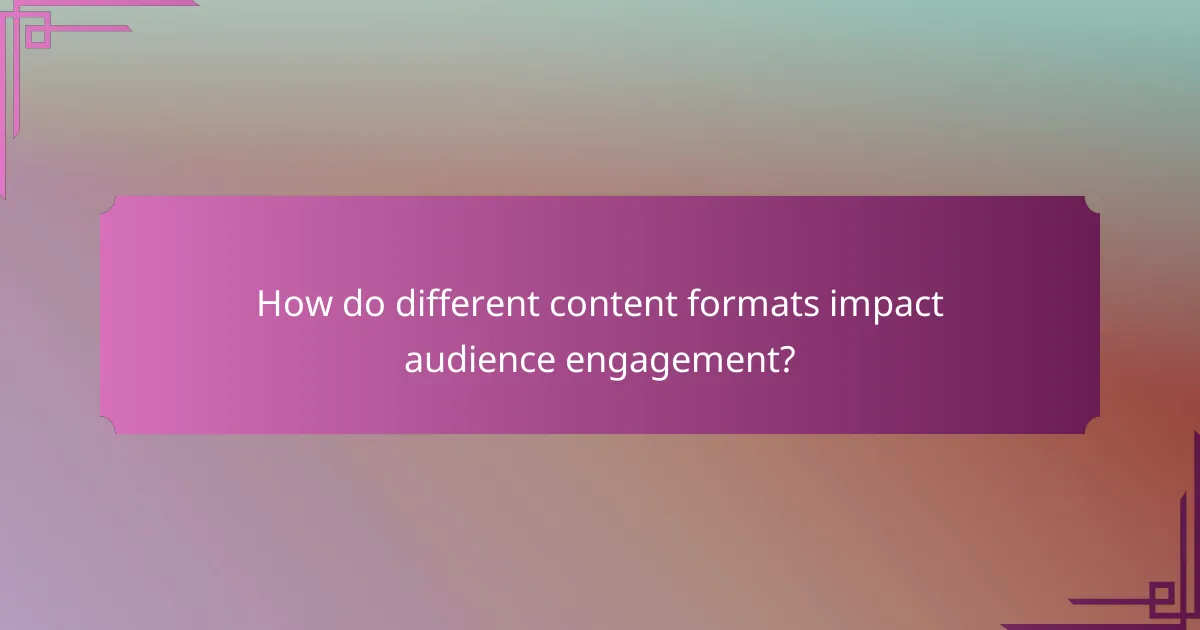
How do different content formats impact audience engagement?
Different content formats significantly influence audience engagement by appealing to various preferences and behaviors. Understanding how each format works can help tailor content strategies to maximize interaction and retention.
Visual formats drive higher engagement
Visual formats, such as infographics and images, tend to capture attention more effectively than text alone. Studies suggest that content with relevant visuals can increase engagement rates by up to 80%. This is because visuals are processed faster by the brain, making them ideal for conveying complex information quickly.
To leverage visual formats, ensure that images are high-quality and relevant to the content. Use infographics to summarize key points or data, as they can simplify complex ideas and make them more digestible for the audience.
Video content retains attention longer
Video content is particularly effective at retaining viewer attention, often keeping audiences engaged for several minutes. Platforms like YouTube report that videos under 2 minutes tend to perform best, as they cater to shorter attention spans while still delivering impactful messages.
When creating video content, focus on storytelling and clear messaging. Use engaging visuals and sound to enhance the experience, and consider including subtitles to make the content accessible to a wider audience.
Interactive formats encourage participation
Interactive formats, such as quizzes, polls, and games, actively involve the audience, which can lead to higher engagement levels. These formats encourage users to participate rather than passively consume content, fostering a sense of community and connection.
To implement interactive formats effectively, consider using tools that allow for easy integration into your website or social media platforms. Keep interactions simple and relevant to your content, and offer incentives, like rewards or recognition, to motivate participation.
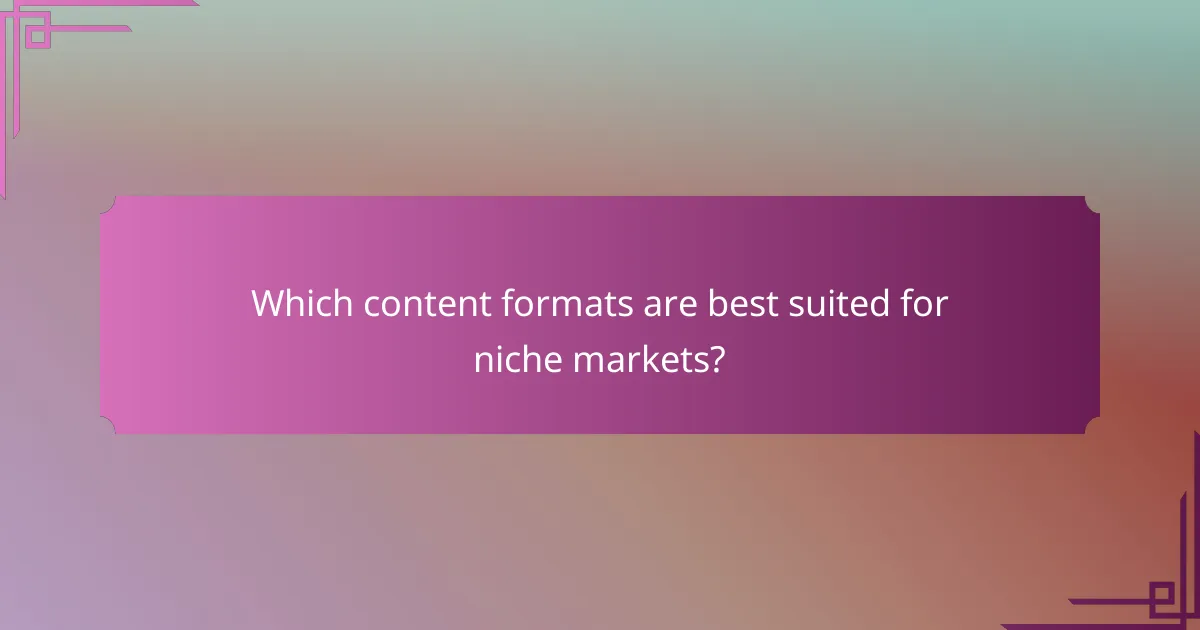
Which content formats are best suited for niche markets?
Content formats that resonate with niche markets typically include long-form articles, podcasts, and webinars. These formats allow for deep engagement and cater to specific interests, making them effective for targeted audiences.
Long-form articles for B2B
Long-form articles are particularly effective in B2B markets as they provide comprehensive insights into industry trends, case studies, and detailed analyses. These pieces often range from 1,500 to 3,000 words, allowing businesses to establish authority and trust with their audience.
To maximize impact, focus on high-quality research and include actionable takeaways. Avoid jargon unless it’s widely understood in the industry, and consider using visuals like charts and infographics to enhance engagement.
Podcasts for tech enthusiasts
Podcasts cater well to tech enthusiasts by offering in-depth discussions on emerging technologies, product reviews, and expert interviews. Episodes typically last between 20 to 60 minutes, making them suitable for listeners who prefer consuming content on-the-go.
When creating tech podcasts, ensure high audio quality and engaging storytelling. Regularly feature industry experts to maintain credibility and keep content fresh. Promote episodes on social media and relevant forums to reach your target audience effectively.
Webinars for educational sectors
Webinars are an excellent format for the educational sector, allowing for interactive learning experiences. They can range from 30 minutes to several hours and often include Q&A sessions to engage participants directly.
To host successful webinars, choose relevant topics that address current challenges in education. Use engaging visuals and encourage participation through polls or chat features. Follow up with recorded sessions and additional resources to reinforce learning and maintain engagement post-event.
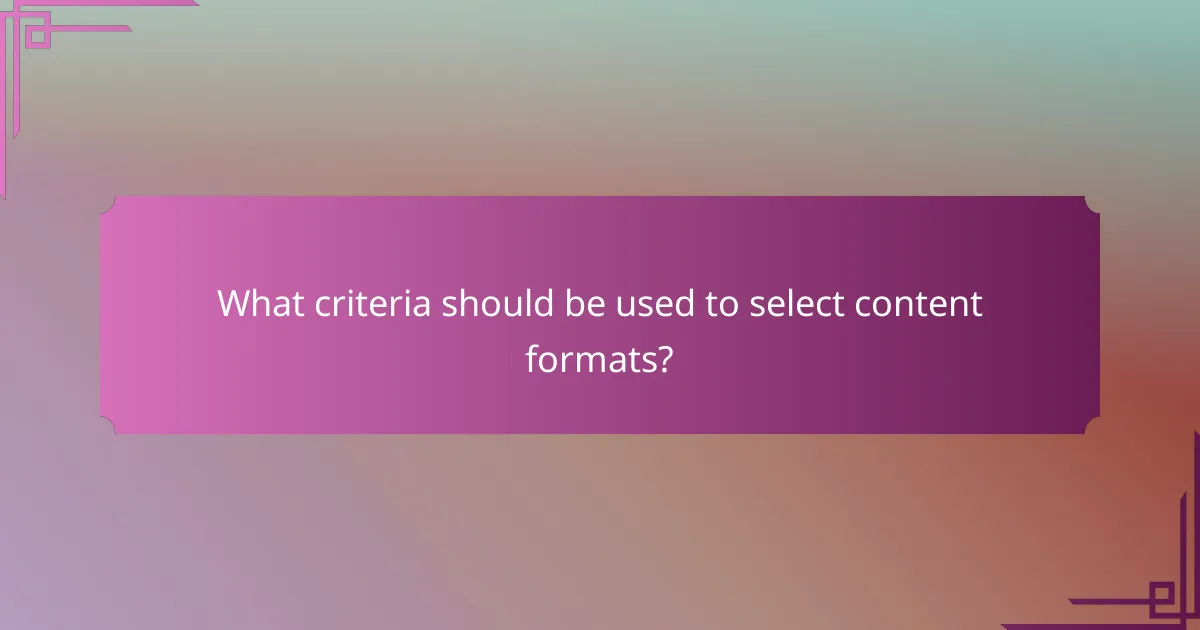
What criteria should be used to select content formats?
Selecting the right content formats involves understanding your audience, aligning with marketing goals, and considering budget constraints. Each of these criteria plays a crucial role in determining which formats will be most effective for your specific needs.
Target audience preferences
Understanding your target audience’s preferences is essential when selecting content formats. Conduct surveys or analyze engagement metrics to identify which formats resonate most with your audience, whether it’s videos, blog posts, infographics, or podcasts.
Consider demographics and psychographics, as younger audiences may prefer video content on platforms like TikTok or Instagram, while older demographics might engage more with traditional articles or newsletters. Tailoring your content format to these preferences can significantly enhance engagement and effectiveness.
Marketing goals alignment
Your content format should align with your overall marketing goals. For instance, if your goal is brand awareness, visually appealing formats like videos or infographics may be more effective. Conversely, if you’re aiming for lead generation, detailed whitepapers or case studies might be more suitable.
Establish clear objectives for your content strategy, and select formats that support these goals. Regularly review and adjust your content formats based on performance metrics to ensure ongoing alignment with your marketing objectives.
Budget considerations
Budget constraints can significantly influence your choice of content formats. High-quality video production, for example, can be costly, while written content may be more budget-friendly. Assess your available resources and determine which formats provide the best return on investment.
Consider leveraging user-generated content or repurposing existing materials to stretch your budget further. Additionally, prioritize formats that require less ongoing investment while still delivering value to your audience, such as blog posts or social media updates.
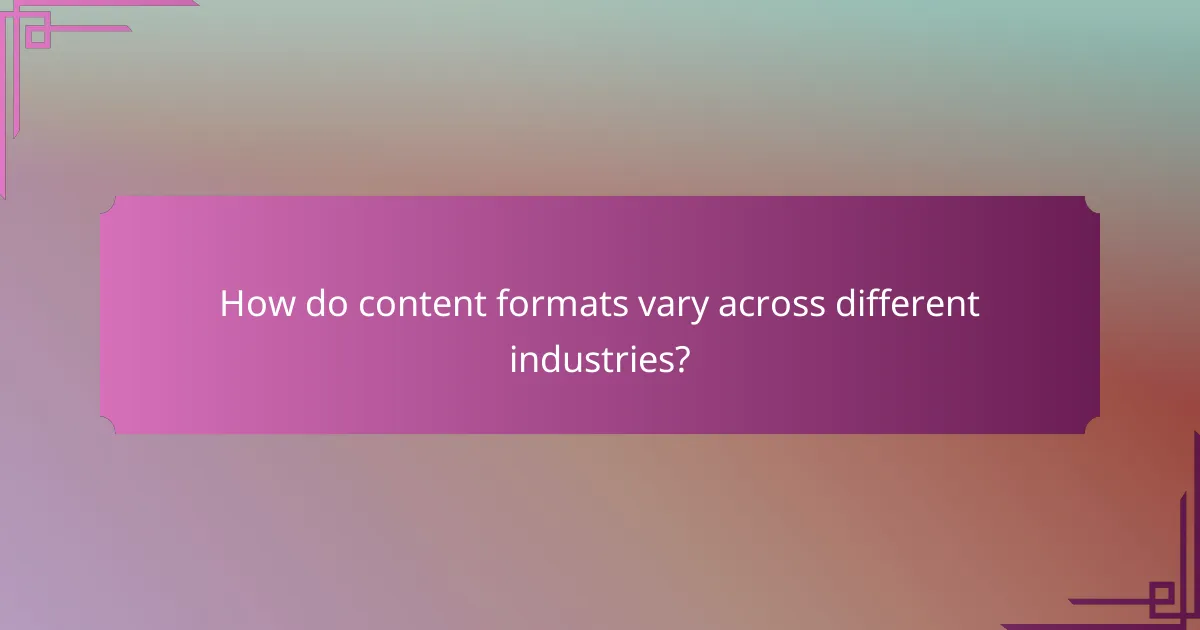
How do content formats vary across different industries?
Content formats differ significantly across industries, shaped by audience preferences and engagement strategies. Each sector employs specific types of content to maximize effectiveness and reach their target demographics.
Fashion industry favors visual content
The fashion industry predominantly uses visual content, such as images and videos, to showcase products and trends. High-quality photographs and runway videos are essential for capturing the aesthetic appeal of clothing and accessories.
Platforms like Instagram and Pinterest are particularly effective for fashion brands, as they emphasize visual storytelling. Brands often utilize lookbooks, influencer collaborations, and style guides to engage their audience and drive sales.
Finance industry utilizes data-driven formats
In the finance sector, content often revolves around data-driven formats like reports, infographics, and webinars. These formats help convey complex information clearly and effectively, making it easier for audiences to understand financial trends and investment strategies.
For example, financial institutions frequently publish market analysis reports and economic forecasts, which are essential for informed decision-making. Additionally, video content explaining financial concepts can enhance comprehension and retention.
Technology industry benefits from tutorials
The technology industry thrives on tutorial-based content, which helps users understand products and services. Step-by-step guides, how-to videos, and webinars are common formats that provide practical knowledge and support.
Companies often create user manuals and online courses to educate customers about their software or hardware. This approach not only enhances user experience but also builds brand loyalty and reduces support queries.
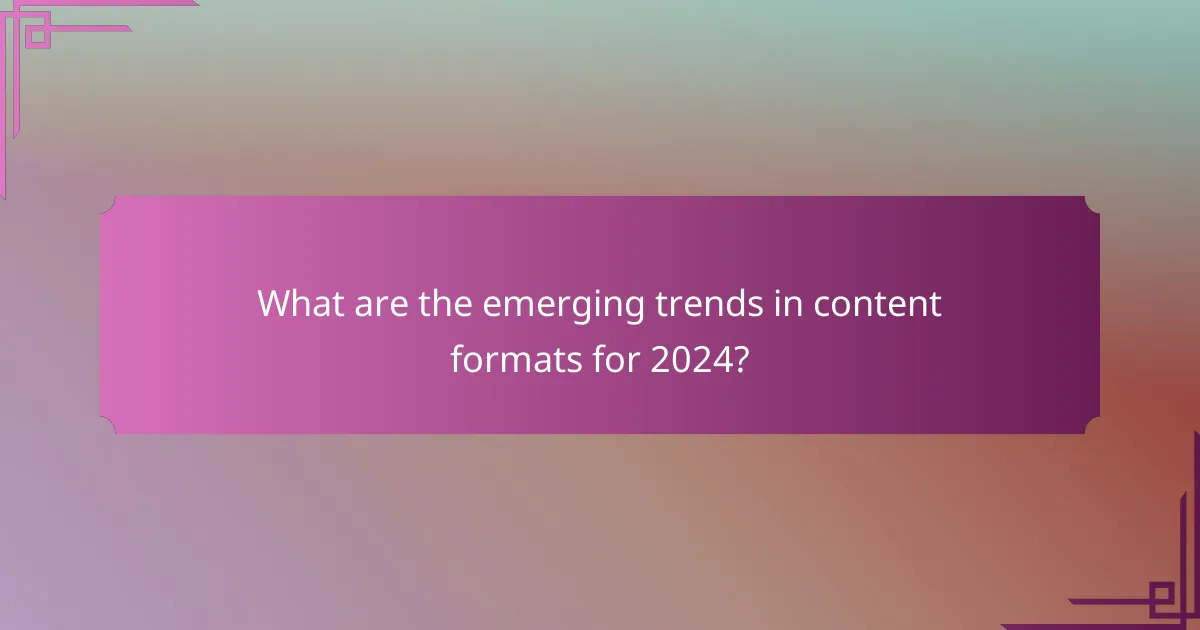
What are the emerging trends in content formats for 2024?
In 2024, content formats are increasingly focused on interactivity, personalization, and immersive experiences. Trends such as short-form video, augmented reality (AR), and user-generated content are gaining traction, reflecting audience preferences for engaging and relatable material.
Short-form Video
Short-form video continues to dominate as a preferred content format, driven by platforms like TikTok and Instagram Reels. These videos, typically lasting under a minute, are effective for quick storytelling and capturing attention in a fast-paced digital environment.
Brands should consider creating concise, visually appealing videos that convey key messages quickly. Engaging hooks and clear calls to action can enhance viewer retention and encourage sharing.
Augmented Reality (AR)
Augmented reality is emerging as a powerful tool for enhancing user engagement. By overlaying digital content in the real world, AR allows brands to create interactive experiences that captivate audiences.
For example, retailers can use AR to let customers visualize products in their own space before purchasing. Implementing AR requires investment in technology but can significantly boost customer interaction and satisfaction.
User-Generated Content (UGC)
User-generated content is becoming essential for building brand authenticity and trust. Encouraging customers to share their experiences and creations fosters community and enhances brand loyalty.
Brands can leverage UGC by creating campaigns that invite users to submit photos or videos featuring their products. This not only provides fresh content but also strengthens the connection between the brand and its audience.


